Abstract
fda from Staphylococcus carnosus TM300, encoding the class I fructose-1,6-bisphosphate aldolase, was cloned in Escherichia coli and sequenced. The 888-nucleotide open reading frame encoding a protein with an M(r) of 32,855 had an E. coli-like promoter sequence. Plasmids containing fda complemented E. coli NP315 (Fda-). Expression of fda in S. carnosus led to a six- to eightfold increase in aldolase production and activity; low levels of glucose in the growth medium stimulated activity.
Full text
PDF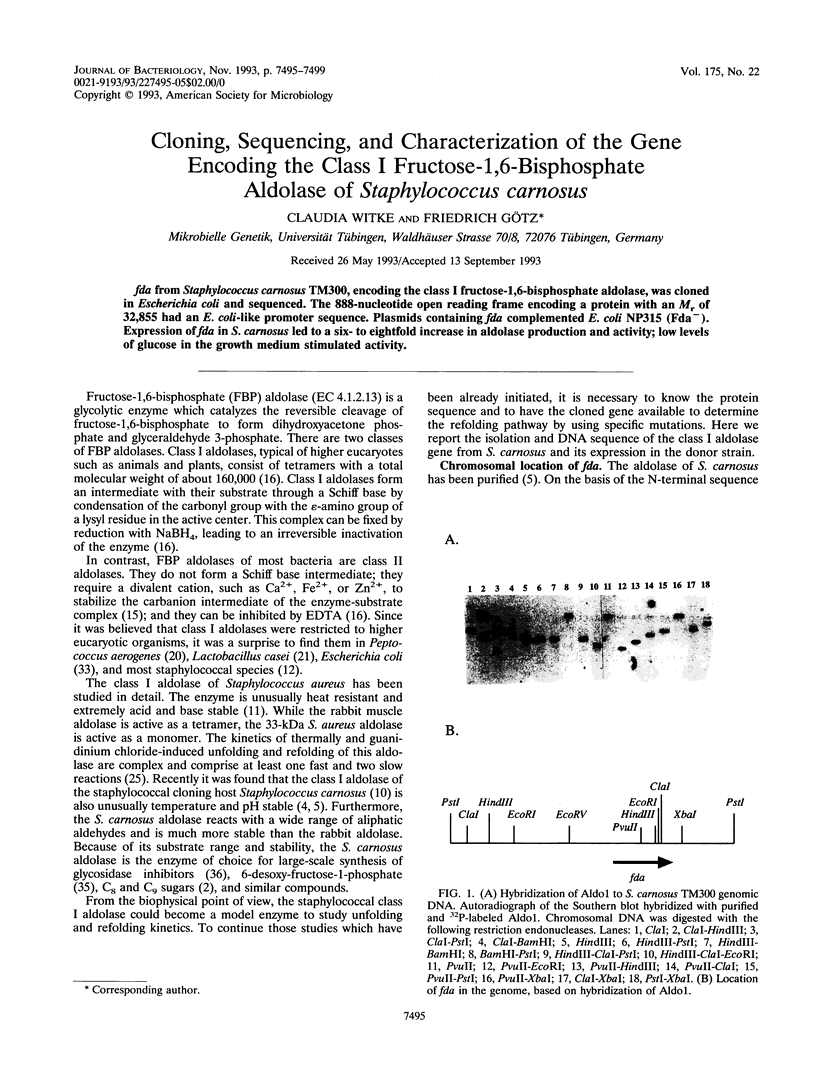
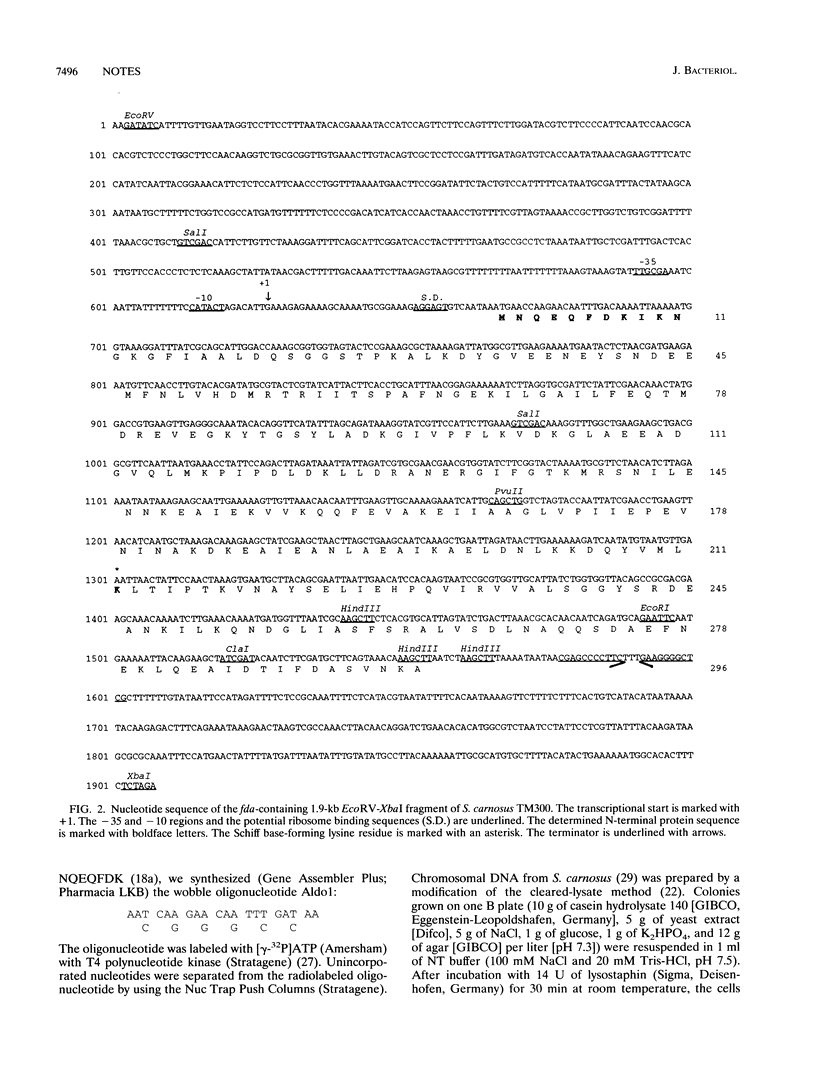
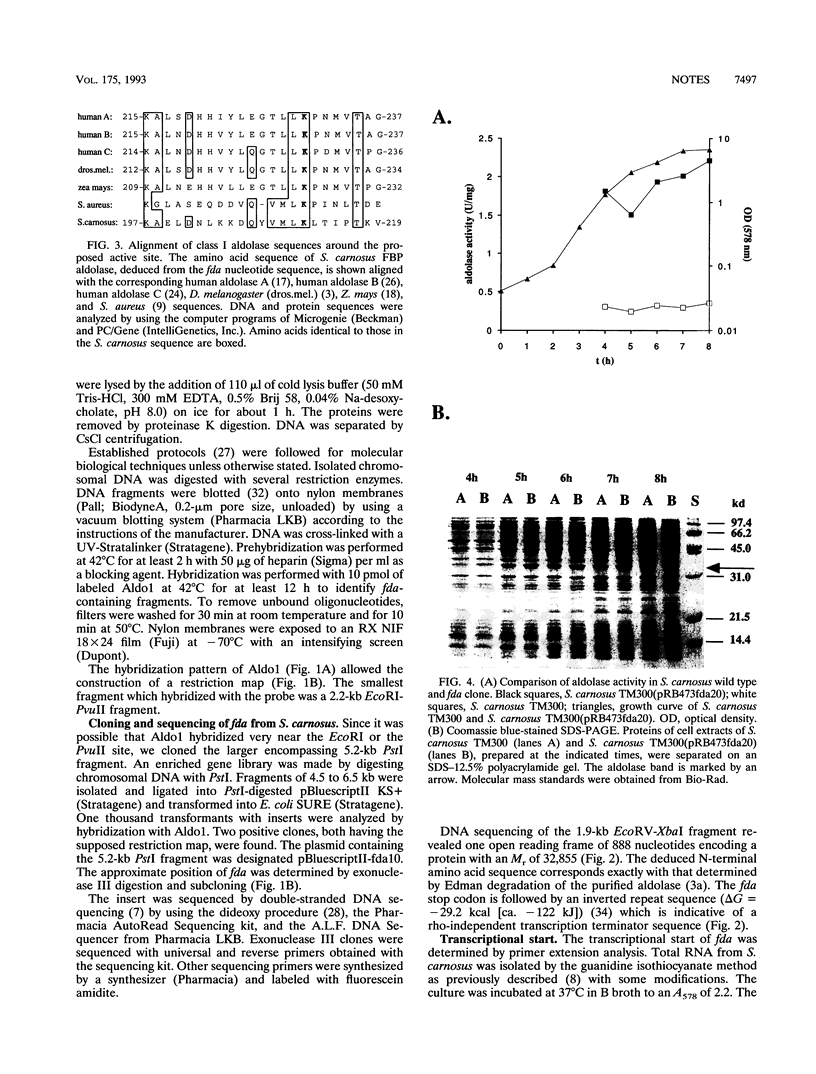
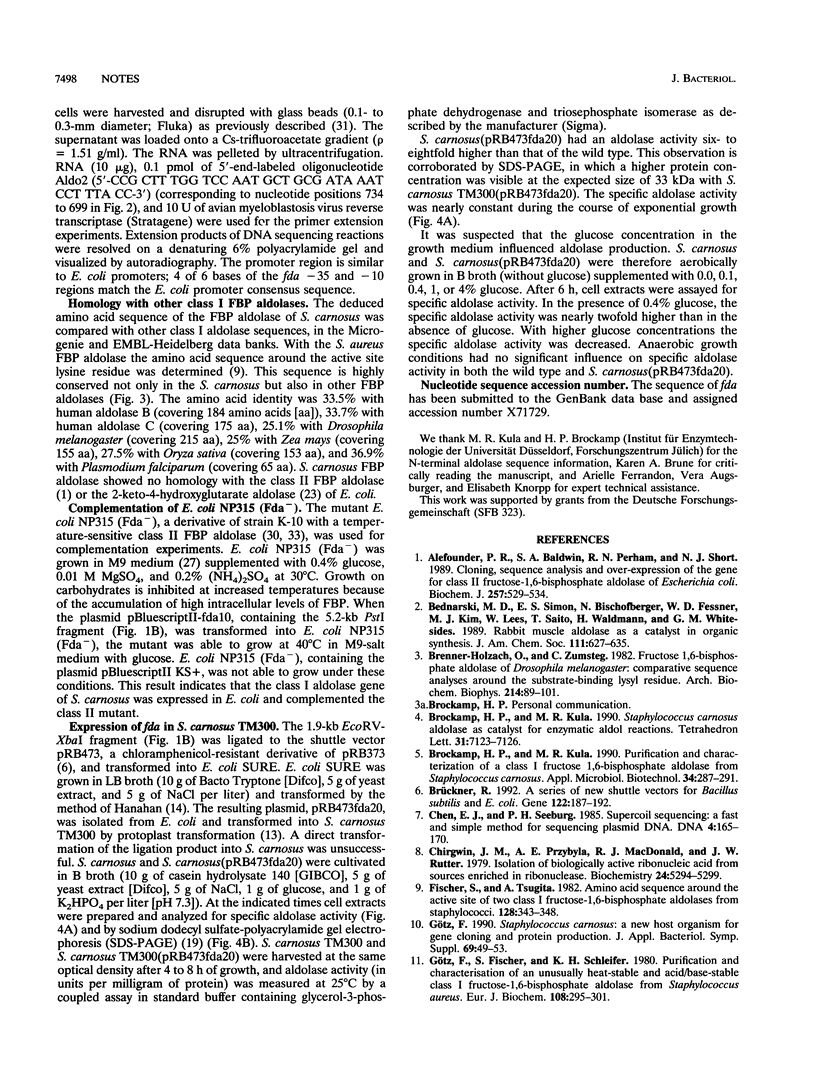
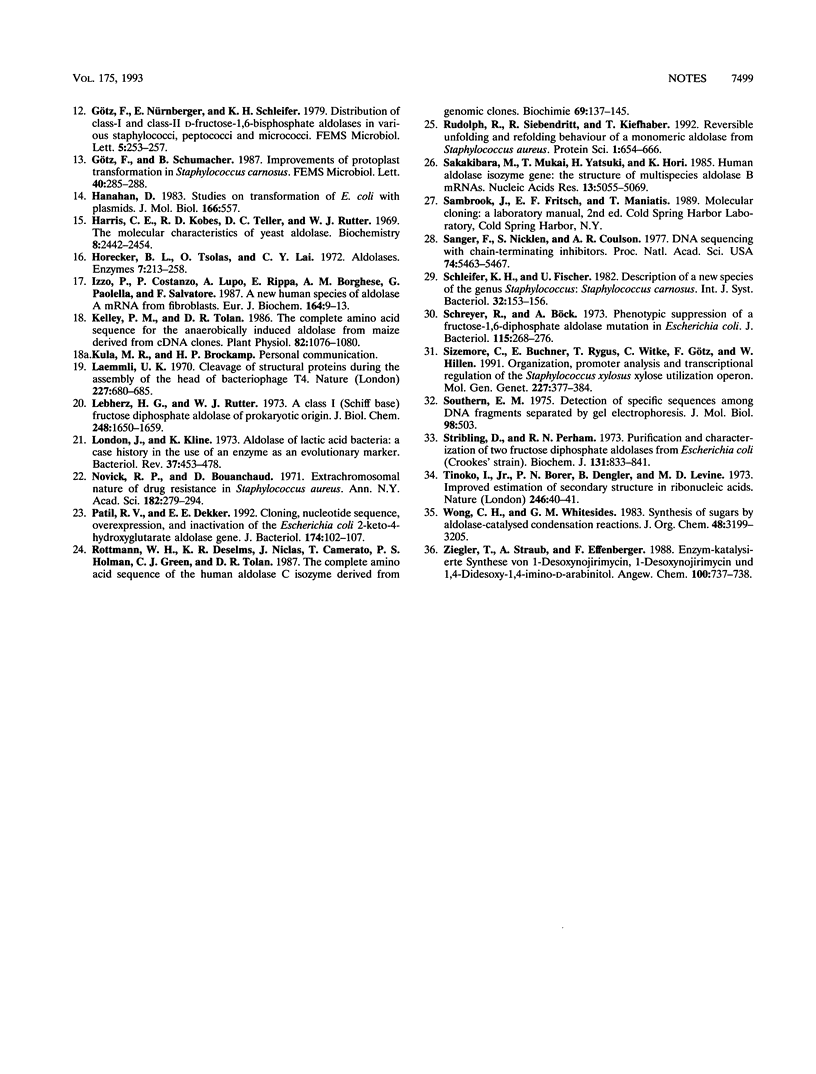
Images in this article
Selected References
These references are in PubMed. This may not be the complete list of references from this article.
- Alefounder P. R., Baldwin S. A., Perham R. N., Short N. J. Cloning, sequence analysis and over-expression of the gene for the class II fructose 1,6-bisphosphate aldolase of Escherichia coli. Biochem J. 1989 Jan 15;257(2):529–534. doi: 10.1042/bj2570529. [DOI] [PMC free article] [PubMed] [Google Scholar]
- Brenner-Holzach O., Zumsteg C. Fructose 1,6-bisphosphate aldolase of Drosophila melanogaster: comparative sequence analyses around the substrate-binding lysyl residue. Arch Biochem Biophys. 1982 Mar;214(1):89–101. doi: 10.1016/0003-9861(82)90011-x. [DOI] [PubMed] [Google Scholar]
- Brückner R. A series of shuttle vectors for Bacillus subtilis and Escherichia coli. Gene. 1992 Dec 1;122(1):187–192. doi: 10.1016/0378-1119(92)90048-t. [DOI] [PubMed] [Google Scholar]
- Chen E. Y., Seeburg P. H. Supercoil sequencing: a fast and simple method for sequencing plasmid DNA. DNA. 1985 Apr;4(2):165–170. doi: 10.1089/dna.1985.4.165. [DOI] [PubMed] [Google Scholar]
- Chirgwin J. M., Przybyla A. E., MacDonald R. J., Rutter W. J. Isolation of biologically active ribonucleic acid from sources enriched in ribonuclease. Biochemistry. 1979 Nov 27;18(24):5294–5299. doi: 10.1021/bi00591a005. [DOI] [PubMed] [Google Scholar]
- Fischer S., Tsugita A. Amino acid sequence around the active site of two class I fructose-1,6-bisphosphate aldolases from staphylococci. Eur J Biochem. 1982 Nov 15;128(2-3):343–348. doi: 10.1111/j.1432-1033.1982.tb06970.x. [DOI] [PubMed] [Google Scholar]
- Götz F., Fischer S., Schleifer K. H. Purification and characterisation of an unusually heat-stable and acid/base-stable class I fructose-1,6-bisphosphate aldolase from Staphylococcus aureus. Eur J Biochem. 1980;108(1):295–301. doi: 10.1111/j.1432-1033.1980.tb04723.x. [DOI] [PubMed] [Google Scholar]
- Hanahan D. Studies on transformation of Escherichia coli with plasmids. J Mol Biol. 1983 Jun 5;166(4):557–580. doi: 10.1016/s0022-2836(83)80284-8. [DOI] [PubMed] [Google Scholar]
- Harris C. E., Kobes R. D., Teller D. C., Rutter W. J. The molecular characteristics of yeast aldolase. Biochemistry. 1969 Jun;8(6):2442–2454. doi: 10.1021/bi00834a029. [DOI] [PubMed] [Google Scholar]
- Izzo P., Costanzo P., Lupo A., Rippa E., Borghese A. M., Paolella G., Salvatore F. A new human species of aldolase A mRNA from fibroblasts. Eur J Biochem. 1987 Apr 1;164(1):9–13. doi: 10.1111/j.1432-1033.1987.tb10984.x. [DOI] [PubMed] [Google Scholar]
- Kelley P. M., Tolan D. R. The complete amino Acid sequence for the anaerobically induced aldolase from maize derived from cDNA clones. Plant Physiol. 1986 Dec;82(4):1076–1080. doi: 10.1104/pp.82.4.1076. [DOI] [PMC free article] [PubMed] [Google Scholar]
- Laemmli U. K. Cleavage of structural proteins during the assembly of the head of bacteriophage T4. Nature. 1970 Aug 15;227(5259):680–685. doi: 10.1038/227680a0. [DOI] [PubMed] [Google Scholar]
- Lebherz H. G., Rutter W. J. A class I (Schiff base) fructose diphosphate aldolase of prokaryotic origin. Purification and properties of Micrococcus aerogenes aldolase. J Biol Chem. 1973 Mar 10;248(5):1650–1659. [PubMed] [Google Scholar]
- London J., Kline K. Aldolase of lactic acid bacteria: a case history in the use of an enzyme as an evolutionary marker. Bacteriol Rev. 1973 Dec;37(4):453–478. doi: 10.1128/br.37.4.453-478.1973. [DOI] [PMC free article] [PubMed] [Google Scholar]
- Novick R. P., Bouanchaud D. The problems of drug-resistant pathogenic bacteria. Extrachromosomal nature of drug resistance in Staphylococcus aureus. Ann N Y Acad Sci. 1971 Jun 11;182:279–294. doi: 10.1111/j.1749-6632.1971.tb30664.x. [DOI] [PubMed] [Google Scholar]
- Patil R. V., Dekker E. E. Cloning, nucleotide sequence, overexpression, and inactivation of the Escherichia coli 2-keto-4-hydroxyglutarate aldolase gene. J Bacteriol. 1992 Jan;174(1):102–107. doi: 10.1128/jb.174.1.102-107.1992. [DOI] [PMC free article] [PubMed] [Google Scholar]
- Rottmann W. H., Deselms K. R., Niclas J., Camerato T., Holman P. S., Green C. J., Tolan D. R. The complete amino acid sequence of the human aldolase C isozyme derived from genomic clones. Biochimie. 1987 Feb;69(2):137–145. doi: 10.1016/0300-9084(87)90246-x. [DOI] [PubMed] [Google Scholar]
- Rudolph R., Siebendritt R., Kiefhaber T. Reversible unfolding and refolding behavior of a monomeric aldolase from Staphylococcus aureus. Protein Sci. 1992 May;1(5):654–666. doi: 10.1002/pro.5560010511. [DOI] [PMC free article] [PubMed] [Google Scholar]
- Sakakibara M., Mukai T., Yatsuki H., Hori K. Human aldolase isozyme gene: the structure of multispecies aldolase B mRNAs. Nucleic Acids Res. 1985 Jul 25;13(14):5055–5069. doi: 10.1093/nar/13.14.5055. [DOI] [PMC free article] [PubMed] [Google Scholar]
- Sanger F., Nicklen S., Coulson A. R. DNA sequencing with chain-terminating inhibitors. Proc Natl Acad Sci U S A. 1977 Dec;74(12):5463–5467. doi: 10.1073/pnas.74.12.5463. [DOI] [PMC free article] [PubMed] [Google Scholar]
- Schreyer R., Böck A. Phenotypic suppression of a fructose-1,6-diphosphate aldolase mutation in Escherichia coli. J Bacteriol. 1973 Jul;115(1):268–276. doi: 10.1128/jb.115.1.268-276.1973. [DOI] [PMC free article] [PubMed] [Google Scholar]
- Sizemore C., Buchner E., Rygus T., Witke C., Götz F., Hillen W. Organization, promoter analysis and transcriptional regulation of the Staphylococcus xylosus xylose utilization operon. Mol Gen Genet. 1991 Jul;227(3):377–384. doi: 10.1007/BF00273926. [DOI] [PubMed] [Google Scholar]
- Southern E. M. Detection of specific sequences among DNA fragments separated by gel electrophoresis. J Mol Biol. 1975 Nov 5;98(3):503–517. doi: 10.1016/s0022-2836(75)80083-0. [DOI] [PubMed] [Google Scholar]
- Stribling D., Perham R. N. Purification and characterization of two fructose diphosphate aldolases from Escherichia coli (Crookes' strain). Biochem J. 1973 Apr;131(4):833–841. doi: 10.1042/bj1310833. [DOI] [PMC free article] [PubMed] [Google Scholar]
- Tinoco I., Jr, Borer P. N., Dengler B., Levin M. D., Uhlenbeck O. C., Crothers D. M., Bralla J. Improved estimation of secondary structure in ribonucleic acids. Nat New Biol. 1973 Nov 14;246(150):40–41. doi: 10.1038/newbio246040a0. [DOI] [PubMed] [Google Scholar]




